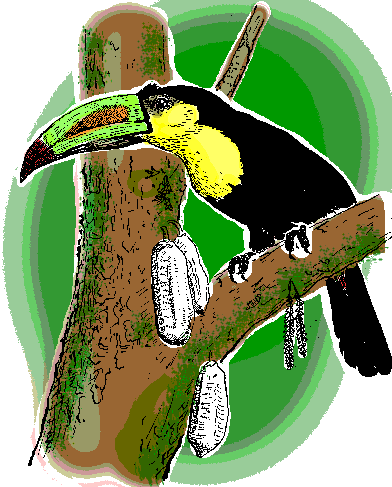| November 17: latitude
18º04'N, longitude 96º47'W MEXICO: Oaxaca; 10 to 20 kms east of San Juan, ±25 kms
east of Huautla de Jiménez, on road between Teotitlán and Tuxtepec, some 30 air-kms east
of Teotitlán; elev. 1000-1200 meters (3300-3900 feet) in the Sierra Mazateca; tropical
deciduous forest, coffee plantations, pastures, with Cecropia and viney aroids
RESIDENCY STATUS:
permanent resident
winter resident
not found in the USA
GULF COAST SPECIAL |
- Black Vulture
- Turkey Vulture
- Sharp-shinned Hawk
- Roadside Hawk
- PLAIN CHACHALACA
- Golden-fronted Woodpecker
- RUFOUS-TAILED HUMMINGBIRD
- WHITE-CROWNED PARROT
- VIOLACEOUS TROGON
- Keel-billed Toucan
- Squirrel Cuckoo
- Groove-billed Ani
- Boat-billed Flycatcher
- BROWN JAY
- BAND-BACKED WREN
- Blue-gray Gnatcatcher
- Nashville Warbler
- Townsend's Warbler
- Wilson's Warbler
- American Redstart
- MELODIOUS BLACKBIRD
- Great-tailed Grackle
- MONTEZUMA OROPENDOLA
- CRIMSON-COLLARED TANAGER
|
Yesterday, just beginning the descent into the Gulf
Lowlands, we celebrated 21% of our species being Gulf-Slope specialties. In this second
list, taken hundreds of feet lower down the slope in habitats with much more of a tropical
element, 38% of the species are Gulf-Slope birds. Northern migrants overwintering here
account for 21% of the species. With all the habitat destruction so obvious around me,
it's clear to see why the populations of so many neotropical migrants are diminishing.
 Despite the
landscape being so hacked-over, the list holds several species that would thrill any
Northern birder. Foremost among these exotics is the Keel-billed
Toucan, sketched at the right.. Add to that the Violaceous
Trogon, the Groove-billed
Ani, the White-crowned Parrot and the Montezuma
Oropendola, and the Northern birder feels in another world.
Despite the
landscape being so hacked-over, the list holds several species that would thrill any
Northern birder. Foremost among these exotics is the Keel-billed
Toucan, sketched at the right.. Add to that the Violaceous
Trogon, the Groove-billed
Ani, the White-crowned Parrot and the Montezuma
Oropendola, and the Northern birder feels in another world.
Still, most of the species in the list are "weed birds" --
species appearing mainly in ecologically disturbed areas. The toucan, croaking like a
frog, appeared in a large avocado tree in a pasture. The parrot was in a coffee plantation
and the trogon perched in a young roadside tree.
The list's Roadside Hawk
lives up to its name. I've never seen it far from a road. It's an unassuming-looking,
upright-perching, squat, brownish bird not as skittish as other hawks.
 Despite the
landscape being so hacked-over, the list holds several species that would thrill any
Northern birder. Foremost among these exotics is the Keel-billed
Toucan, sketched at the right.. Add to that the Violaceous
Trogon, the Groove-billed
Ani, the White-crowned Parrot and the Montezuma
Oropendola, and the Northern birder feels in another world.
Despite the
landscape being so hacked-over, the list holds several species that would thrill any
Northern birder. Foremost among these exotics is the Keel-billed
Toucan, sketched at the right.. Add to that the Violaceous
Trogon, the Groove-billed
Ani, the White-crowned Parrot and the Montezuma
Oropendola, and the Northern birder feels in another world.